- Uneven Wear or Scoring On Both Sides of Band
- Heavy Wear and/or Swaging On Back Edge
- Butt Weld Breakage
- Heavy Wear in Only the Smallest Gullets
- Body Breakage – Angular Direction
- Body Breakage or Cracks From Gullet
- Band is Twisted into a Figure “8”
- Used Band is “Long” On The Tooth Edge
- Used Band is “Short” On The Tooth Edge
- Broken Band Shows a Twist in Band Length
Heavy Even Wear On Tips and Corner or Teeth

The wear on teeth is smooth across the tips and the corners of set teeth have become rounded.
Probable Cause:
- Improper break-in procedure
- Excessive band speed for the type of material being cut. This generates high tooth tip temperature resulting in accelerated tooth wear.
- Low feed rate causes teeth to rub instead of penetrate. This is most common on work hardened materials such as stainless and tool steels.
- Hard materials being cut such as “Flame Cut Edge” or abrasive materials such as “Fiber Reinforced Composites”.
- Insufficient sawing fluid due to inadequate supply, improper ratio, and/or improper application.
Wear On Both Sides of Teeth
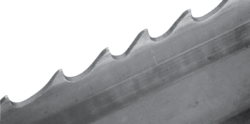
The side of teeth on both sides of band have heavy wear markings.
Probable Cause:
- Broken, worn or missing back-up guides allowing teeth to contact side guides.
- Improper side guides for band width.
- Backing the band out of an incomplete cut.
Wear On One Side of Teeth

Only one side of teeth has heavy wear markings.
Probable Cause:
- Worn wheel flange, allowing side of teeth to contact wheel surface or improper tracking on flangeless wheel.
- Loose or improperly positioned side guides.
- Blade not perpendicular to cut.
- Blade rubbing against cut surface on return stroke of machine head.
- The Teeth rubbing against a part of machine such as chip brush assembly, guards, etc.
Chipped or Broken Teeth
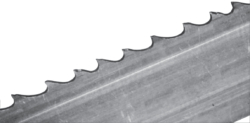
A scattered type of tooth breakage of tips and corners of the teeth.
Probable Cause:
- Improper break-in procedure.
- Improper blade selection for application.
- Handling damage due to improper opening of folded band.
- Improper positioning or clamping of material.
- Excessive feed rate or pressure.
- Hitting Hard spots or hard scale in material.
Body Breakage or Cracks from Back Edge
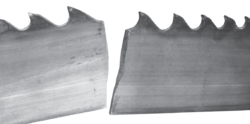
The fracture originates from the back edge of the band. The origin of the fracture is indicated by a flat area on the fractured surface.
Probable Cause:
- Excessive back-up guide “preload” will cause back edge to work harden which results in cracking.
- Excessive feed rate.
- Improper band tracking – back edge rubbing heavily of wheel flange.
- Worn or defective back-up guides.
- Improper band tension.
- Notches in back edge from handling damage.
Tooth Strippage
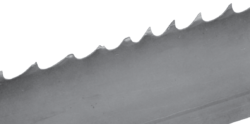
Section or sections of teeth which broke from the band backing.
Probable Cause:
- Improper or lack of break-in procedure.
- Worn, missing or improperly positioned chip brush.
- Excessive feed rate or feed pressure.
- Movement or vibration of material being cut.
- Improper tooth pitch for cross sectional size of material being cut.
- Improper positioning of material being cut.
- Insufficient sawing fluid due to inadequate supply, improper ratio and/or improper application.
- Hard spots in material being cut.
- Band speed too slow for grade of material being cut.
Chips Welded to Tooth Tips
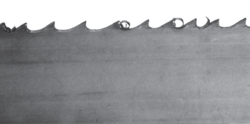
High temperature or pressure generated during the cut bonding the chips to the tip and face of the teeth.
Probable Cause:
- Insufficient sawing fluid due to inadequate supply, improper ratio and/or improper application.
- Worn, missing or improperly positioned chip brush.
- Improper band speed.
- Improper feed rate.
Gullets Loading up with Material
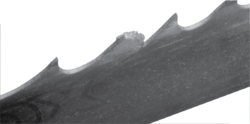
Gullet area has become filled with material being cut.
Probable Cause:
- Too fine of a tooth pitch – insufficient gullet capacity.
- Excessive feed rate producing too large of a chip.
- Worn, missing or improperly positioned chip brush.
- Insufficient sawing fluid due to inadequate supply, improper ration and/or improper application.
Discolored Tips of Teeth

The tooth tips show a discolored surface from generating an excessive amount of frictional heat during use.
Probable Cause:
- Insufficient sawing fluid due to inadequate supply, improper ratio and/or improper application.
- Excessive band speed.
- Improper feed rate.
- Band installed backwards.
Heavy Wear On Both Sides of Band
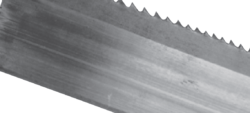
Both sides of band have heavy wear patterns.
Probable Cause:
- Chipped or broken side guides.
- Side guide adjustments may be too tight.
- Insufficient flow of sawing fluid through the side guides.
- Insufficient sawing fluid due to inadequate supply, improper ration and/or improper application.
Uneven Wear or Scoring On Both Sides of Band
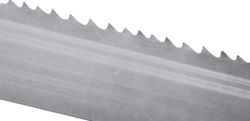
Wear patterns are near gullet area on one side and near back edge on opposite side.
Probable Cause:
- Loose side guides.
- Chipped, worn or defective side guides.
- Band is rubbing on part of the machine.
- Guide arms spread to maximum capacity.
- Accumulation of chips in side guides.
Heavy Wear and/or Swaging On Back Edge
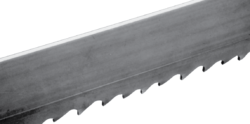
Heavy back edge wear will have a polished appearance or abnormal grooves worn into the surface. Swaging of corners can also occur.
Probable Cause:
- Excessive feed rate.
- Excessive back-up guide “preload”.
- Improper band tracking – back edge rubbing heavily on wheel flange.
- Worn or defective back-up guides.
Butt Weld Breakage
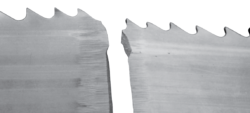
To determine if the band broke at the weld, inspect the sides at the fracture to see if there are grind markings from the weld finishing process.
Probable Cause:
- Any of the factors that cause body breakages can also cause butt weld breaks. (See observations 5, 15 & 16)
Heavy Wear in Only the Smallest Gullets

Heavy wear in only the smallest gullets is an indication that there is a lack of gullet capacity for the chips being produced.
Probable Cause:
- Excessive feed rate.
- Band speed too slow.
- Using too find of a tooth pitch for the size of material being cut.
Body Breakage – Angular Direction

The fracture originates in the gullet and immediately travels in an angular direction into the backing of the band.
Probable Cause:
- An excessive twist type of stress exists.
- Guide arms spread to capacity causing excessive twist from band wheel to guides.
- Guide arms spread too wide while cutting small cross sections.
- Excessive back-up guide “preload”.
Body Breakage or Cracks From Gullet
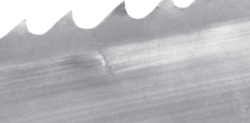
The origin of the fracture is indicated by a flat area on the fracture surface.
Probable Cause:
- Excessive back-up guide “preload”.
- Improper band tension.
- Guide arms spread to maximum capacity.
- Improper beam bar alignment.
- Side guide adjustment is too tight.
- Excessively worn teeth.
Band is Twisted into a Figure “8”
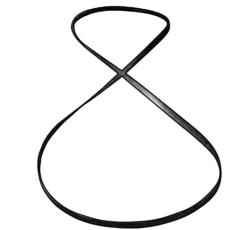
The band does not retain its normal shape while holding the sides of the loop together. This indicate the flatness has been altered during use.
Probable Cause:
- Excessive band tension.
- Any of the band conditions which cause the band to be long (18) or short (19) on the tooth edge.
- Cutting a tight radius.
Used Band is “Long” On The Tooth Edge
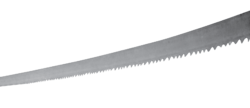
“Long” on the tooth edge is a term used to describe the straightness of the band. The teeth are on the outside of the arc when the strip is lying on a flat surface.
Probable Cause:
- Side guides are too tight – rubbing near gullets.
- Excessive “preload” – band riding heavily against back-up guides.
- Worn band wheels causing uneven tension.
- Excessive feed rate.
- Guide arms are spread to maximum capacity.
- Improper band tracking – back edge rubbing heavy on wheel flange.
Used Band is “Short” On The Tooth Edge
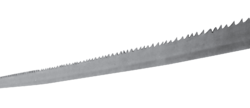
“Short” on the tooth edge is a term used to describe the straightness of the band. The teeth are on the inside of the arc when the strip is lying on a flat surface.
Probable Cause:
- Side guides are too tight – rubbing near back edge.
- Worn band wheels causing uneven tension.
- Guide arms are spread too far apart.
- Excessive feed rate.
Broken Band Shows a Twist in Band Length

When a broken band lying on a flat surface displays a twist from one end to the other, this indicates the band flatness has been altered during use.
Probable Cause:
- Excessive band tension.
- Any of the band conditions which cause the band to be long (18) or short (19) on the tooth edge.
- Cutting a tight radius.
